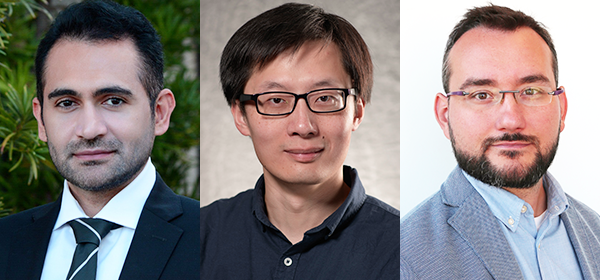Three Engineering Faculty Win NSF CAREER Awards

Feb. 12, 2025 - Three UC Irvine engineering assistant professors – Hamidreza Aghasi, Sitao Huang and Erdem Sasmaz -- have been recognized this year with Faculty Early Career Development (CAREER) awards from the National Science Foundation. Among NSF’s most prestigious honors, the CAREER award supports young faculty who are academic role models in research and education.
Aghasi, an assistant professor in electrical engineering and computer science, received $550,000 from the Division of Electrical, Communications and Cyber Systems to improve the scalability and efficiency of radar systems for applications in security, healthcare and industrial monitoring.
Understanding and interpreting the world with precision is vital for modern technologies that enhance safety, efficiency and quality of life. Radar systems play a key role as they operate reliably in all weather conditions, including heavy rain, fog and darkness. However, current radar and imaging systems face challenges such as low resolution, high power consumption and complex calibration, all of which can limit their scalability and widespread use.
Aghasi’s project addresses these issues through innovative designs of scalable radar transceivers and bio-inspired super-resolution techniques. Using mm-wave and sub-THz frequencies, the system achieves meter-scale radar coverage and mm-scale resolution. “By adopting machine learning algorithms, the data processing inside large arrays is simplified, and by enhancing the temporal efficiency, an almost-real-time perception of the environment can be realized,” said Aghasi. “These breakthroughs will enable transformative applications, including safer autonomous systems, real-time security monitoring, precise environmental analysis and advanced biomedical diagnostics.”
Huang, an assistant professor in electrical engineering and computer science, was awarded $650,000 from the Division of Computing and Communication Foundation. His project focuses on fundamental research in electronic design automation tools, aimed at accelerating the development of modern computing systems and design methodology.
As the complexity of modern computing workloads grow, existing computer systems with uniform processors or accelerators have critical limitations for computing complicated jobs. Huang says the next generation of heterogeneous hardware accelerations systems will require diverse processors and accelerators, including central processing units (CPUs), graphics processing units (GPUs), digital signal processors (DSPs), field-programmable gate arrays (FPGAs) and domain-specific accelerators as well as their design automation and programming tools.
Huang plans to develop an efficient compilation and system synthesis flow that compiles high-level programs into domain-specific reconfigurable heterogeneous acceleration systems. “The design productivity improvement from this project could potentially mitigate the hardware design efficiency and workforce shortage problem we are facing today,” said Huang, “and directly translate into a larger semiconductor market and more domestic job openings.”
Sasmaz, an assistant professor in chemical and biomolecular engineering, received $550,000 from the Division of Chemical, Bioengineering, Environmental and Transport Systems, for his work on advancing decarbonization technologies within the chemical industry.
The decarbonization of transport, manufacturing and power generation sectors hinges on breakthrough technological improvements. Sasmaz’s project aims to design and implement modular induction heating reactors to enhance the energy-efficient production of essential chemicals, such as propylene, a vital compound used in the synthesis of various organic substances and polymers.
Direct propane dehydrogenation (PDH) is the preferred technique for large-scale production of propylene, as opposed to steam and fluid catalytic cracking processes. However, PDH suffers from catalyst deactivation due to coke formation, or a residual pure carbon deposit.
This leads to a substantial amount of unused carbon, posing a sustainability challenge. The growing demand for propylene drives the need to enhance propylene yield in a way that minimizes carbon loss. Sasmaz says the goal of his CAREER project is to develop a comprehensive understanding of the influence of localized heating and magnetization on the reaction mechanism and activity of inductively heated PDH catalysts and improve overall carbon efficiency. “The insights gained from this work will contribute to the development of new catalyst chemistry and high-efficiency induction heating systems for heterogeneous reactions.”
– Lori Brandt
